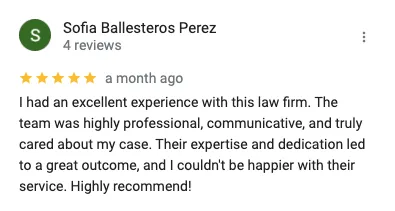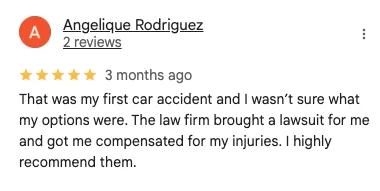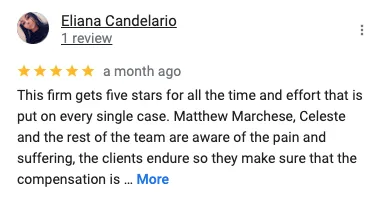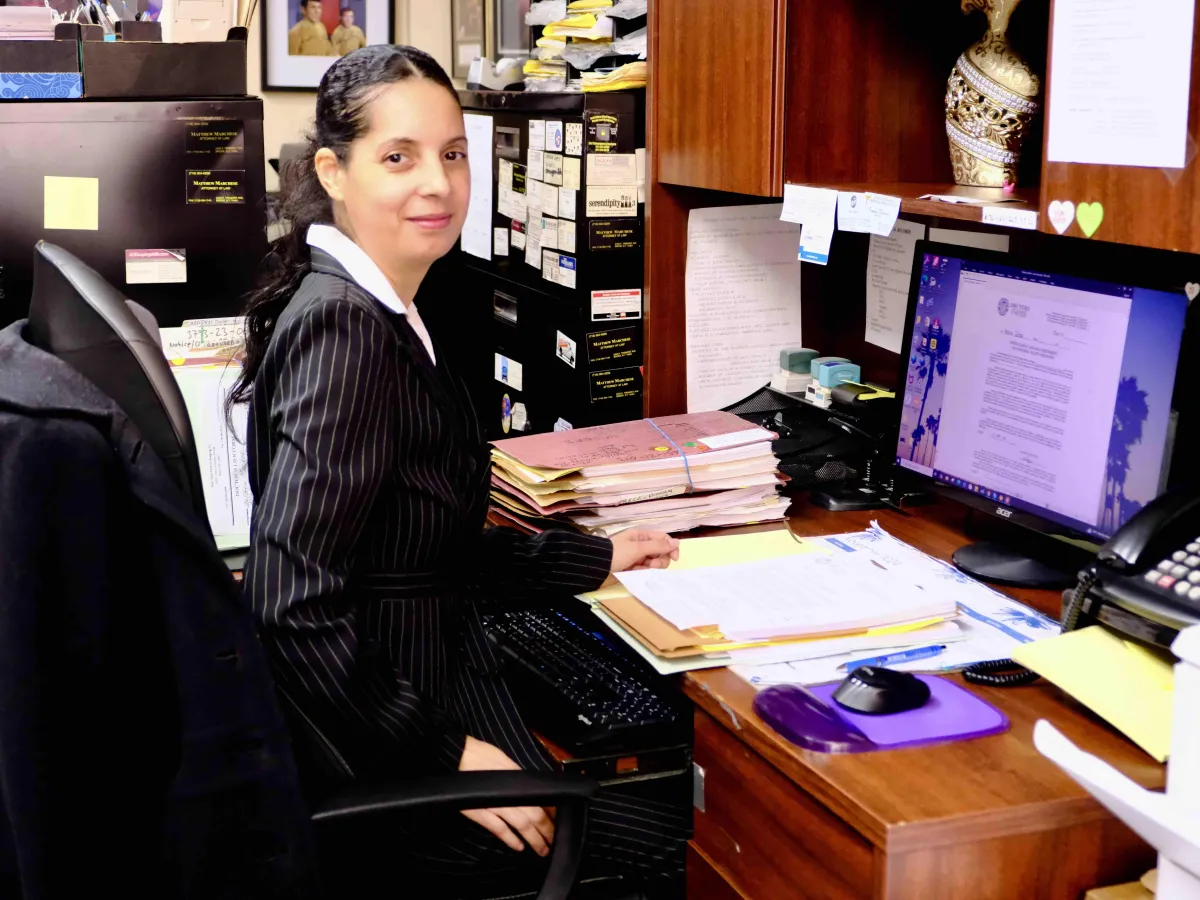Car Accident Lawyer in the Bronx
We help Bronx drivers and pedestrians — especially when big firms say no.
From Matt: Hey, It's Matt Marchese from MyBronxLawyer.com. If you were in a car accident in the Bronx — even a small one — don’t wait to get help. What seems minor now can lead to months of pain, lost income, and insurance headaches.We handle crashes on the Deegan, Cross Bronx, Bronx River Parkway — and we’ve seen how insurance companies try to lowball Bronx drivers. If a big firm told you no — or you don’t know if your case is “worth it” — talk to us first.
What Counts as a Car Accident Case?
Car accidents include any incident involving a motor vehicle that causes injury or damage, regardless of whether the person involved was a driver, passenger, pedestrian, or cyclist.
- Rear-end collisions
- Intersection crashes
- Hit-and-run incidents
- Pedestrian struck by a car
- Side-impact or “T-bone” accidents
- Accidents involving Uber, Lyft, or delivery vehicles
In New York, even minor collisions can become serious depending on the injuries and follow-up care. A car accident case is typically based on whether there was harm that required treatment or caused a disruption to daily life.
Where Do Most Car Accidents Happen in the Bronx?
Several major Bronx roadways experience a high volume of collisions each year. These include expressways with fast-moving traffic, local corridors with congestion, and intersections where pedestrians and vehicles cross paths frequently.
Factors like lane merges, limited visibility, aggressive driving, and inconsistent road conditions contribute to higher crash rates in specific areas. Certain stretches have become known for frequent incidents, especially during rush hour.
- Cross Bronx Expressway (I-95)
- Major Deegan Expressway (I-87)
- Fordham Road at Jerome Avenue
- Bruckner Boulevard near Hunts Point
- Pelham Parkway intersections
Official data on Bronx crash locations is published by NYPD and available through the NYPD Traffic Reports portal.
What Should Be Done Right After a Car Accident?
The first priority is safety. Check for injuries, move to a safe area if possible, and call 911 if anyone is hurt. Even minor collisions can involve injuries that aren't immediately obvious, so medical attention is often necessary.
Once safe, begin gathering information. This includes contact details, photos of the scene, and any statements made by others involved. Not all injuries or damage are visible at the scene, so documentation helps protect your rights later.
- Call 911 and wait for police to arrive
- Seek medical attention, even if symptoms seem minor
- Photograph vehicles, street signs, and visible injuries
- Exchange names, insurance info, and plate numbers
- File a report with the NYPD and obtain the report number
Accident reports can be requested online through the CrashDocs NYPD portal if you have the date and plate number.
When Do Car Accident Injuries Show Up?
Some injuries are obvious at the scene of a crash, but others may take hours or even days to appear. This delay is common in accidents involving muscle strain, nerve irritation, or internal impact where adrenaline masks the symptoms early on.
Prompt medical attention is important even if no pain is felt right away. Medical providers are trained to detect early signs of trauma that could worsen without treatment. Delayed care may also create gaps in documentation that affect how the accident is handled later.
- Neck and back pain may appear 24–72 hours later
- Concussions and head injuries can develop gradually
- Whiplash is often delayed but serious
- Soft tissue injuries may not bruise until the next day
- Emotional effects like anxiety or sleep issues can take time to emerge
Who Is at Fault in a Car Accident?
Fault in a car accident is determined based on traffic laws, road conditions, and evidence gathered at the scene. In New York, drivers are expected to follow rules regarding right of way, safe following distance, and appropriate speed. When those rules are broken, fault is often assigned based on what could have been prevented.
In multi-vehicle collisions or unclear situations, investigators may assign partial fault to more than one party. New York follows a comparative fault system, which means more than one person can be held responsible depending on the facts.
- Rear-end collisions are typically the rear driver’s fault
- Left-turn crashes often fault the turning driver
- Failure to yield at signs or signals is a common violation
- Speeding or distracted driving may shift responsibility
- Pedestrians may share fault if crossing outside legal zones
How Do Insurance Companies Handle Car Accidents?
Insurance companies begin evaluating a claim as soon as an accident is reported. Their process includes reviewing the police report, medical records, photos, and any recorded statements. In no-fault states like New York, the driver’s own insurance typically pays for initial medical treatment regardless of who caused the crash.
- No-fault coverage pays for basic medical bills and lost wages
- Liability claims require proof of fault and damages
- Delays may occur if reports, treatment, or records are incomplete
- Recorded statements may be reviewed for inconsistencies
- Surveillance or social media may be used to evaluate claims
When injuries are serious or costs go beyond no-fault limits, the claim may be reviewed under a third-party liability process. In those cases, adjusters look closely at evidence to determine whether compensation is owed and how much responsibility each party holds.
Can You Still File a Claim if You Didn’t Go to the Hospital?
Yes — a hospital visit is not the only way to document an injury. Many people go to urgent care, a local doctor, or delay treatment for a day or more. What matters most is that there’s medical documentation connecting the injury to the accident.
- Urgent care visits, even days later, are valid medical records
- Primary care, telehealth, or follow-up clinics are also accepted
- Insurance companies may question long delays with no treatment
- Gaps in care can reduce how seriously a claim is viewed
- Documentation should include the date, symptoms, and cause
For more guidance, see how Urgent Care treatment impacts your case. — including how to document injuries after a delay.
What Happens If the Other Driver Has No Insurance?
When the at-fault driver is uninsured or underinsured, New York law allows injured parties to file a claim through their own policy under Uninsured Motorist (UM) or Underinsured Motorist (UIM) coverage. This coverage is built into most auto policies and provides a backup source of compensation.
- UM/UIM covers medical bills, lost wages, and other damages
- It applies if the at-fault driver has no insurance or flees the scene
- Claims still require proof of fault and injury
- The insurance company becomes the opposing party in the claim
- Hit-and-run cases are often handled the same way as uninsured driver claims
Uninsured motorist claims have strict deadlines and notice requirements. Early reporting to your own insurer is critical when the other driver cannot be located or lacks coverage.
How Long Do You Have to Take Action After a Car Accident in NY?
New York has strict deadlines for filing legal claims after a car accident. These rules fall under what’s called the “statute of limitations.” The timeline depends on what kind of claim is being filed, who’s involved, and how serious the injuries are. Once the deadline passes, the case is usually no longer valid.
- Most personal injury claims: 3 years from the date of the accident
- Wrongful death claims: 2 years from the date of death
- Claims against the City or State: 90 days to file a notice of claim
- No-fault insurance (medical bills): must be filed within 30 days
- Uninsured motorist claims: often must be reported immediately
Early action is important because certain deadlines come much sooner than expected — especially when city vehicles, government property, or no-fault paperwork are involved.
What Makes One Car Accident Case Different From Another?
No two car accident cases are identical, even if the collisions seem similar. Outcomes can vary based on where the accident happened, how clear the fault is, and the kind of medical treatment involved. Small details in timing, documentation, or witness statements can change how a case is handled.
Factors like long treatment gaps, minor property damage, or pre-existing injuries don’t automatically disqualify a case — but they do affect how the case is evaluated. Each situation is weighed on its own facts and the available evidence.
- Location of the crash (e.g., intersection vs. highway)
- Type and severity of injury
- How soon medical care was received
- Whether the other party admitted fault or denied it
- Availability of photos, witnesses, or video footage
How to Request Records, Reports, or Evidence
Accident-related records are often critical when dealing with insurance companies or proving what happened. These include police reports, urgent care or hospital records, EMS reports, and any photographs or surveillance footage. Gathering this information early helps avoid delays and protects your position if questions come up later.
Each type of record is requested through a different agency or provider. Some require a formal request or ID, while others may be available online for a fee.
- Police reports (NYPD) can be requested at CrashDocs.org
- Urgent care and hospital records can be requested through the facility’s medical records department
- EMS reports may require a request to FDNY or private ambulance services
- Dashcam or surveillance footage must be requested from the owner or location where the footage was captured
- Photos from the scene should be saved and backed up immediately
Helpful Info
What Should You Do
After Visiting Urgent Care?
If you’ve been to urgent care after a car accident or fall, you’re not alone — it’s one of the most common first steps. But urgent care notes alone aren’t always enough. Here’s what matters next, and how to protect your health and case.
Learn more →Learn More
Explore specific legal issues tied to real Bronx neighborhoods and crash types. These resources help explain what to expect if you were injured in one of these common local scenarios.
Call 7 days a week 9am-9pm.
LET'S TALK
VISIT US
© 2025 Matthew Marchese P.C. All Rights Reserved
Law Firm of Matthew Marchese, 2403 East Tremont Avenue, Bronx, NY, 10461
The information on this website is for general information purposes only. Nothing on this site should be construed as legal advice in any particular case. The information does not create an attorney-client relationship. Attorney advertising. Prior results do not guarantee a similar outcome.
We handle crashes on the Deegan, Cross Bronx, Bronx River Parkway — and we’ve seen how insurance companies try to lowball Bronx drivers. If a big firm told you no — or you don’t know if your case is “worth it” — talk to us first.
What Counts as a Car Accident Case?
Car accidents include any incident involving a motor vehicle that causes injury or damage, regardless of whether the person involved was a driver, passenger, pedestrian, or cyclist.
- Rear-end collisions
- Intersection crashes
- Hit-and-run incidents
- Pedestrian struck by a car
- Side-impact or “T-bone” accidents
- Accidents involving Uber, Lyft, or delivery vehicles
In New York, even minor collisions can become serious depending on the injuries and follow-up care. A car accident case is typically based on whether there was harm that required treatment or caused a disruption to daily life.
Where Do Most Car Accidents Happen in the Bronx?
Several major Bronx roadways experience a high volume of collisions each year. These include expressways with fast-moving traffic, local corridors with congestion, and intersections where pedestrians and vehicles cross paths frequently.
Factors like lane merges, limited visibility, aggressive driving, and inconsistent road conditions contribute to higher crash rates in specific areas. Certain stretches have become known for frequent incidents, especially during rush hour.
- Cross Bronx Expressway (I-95)
- Major Deegan Expressway (I-87)
- Fordham Road at Jerome Avenue
- Bruckner Boulevard near Hunts Point
- Pelham Parkway intersections
Official data on Bronx crash locations is published by NYPD and available through the NYPD Traffic Reports portal.
What Should Be Done Right After a Car Accident?
The first priority is safety. Check for injuries, move to a safe area if possible, and call 911 if anyone is hurt. Even minor collisions can involve injuries that aren't immediately obvious, so medical attention is often necessary.
Once safe, begin gathering information. This includes contact details, photos of the scene, and any statements made by others involved. Not all injuries or damage are visible at the scene, so documentation helps protect your rights later.
- Call 911 and wait for police to arrive
- Seek medical attention, even if symptoms seem minor
- Photograph vehicles, street signs, and visible injuries
- Exchange names, insurance info, and plate numbers
- File a report with the NYPD and obtain the report number
Accident reports can be requested online through the CrashDocs NYPD portal if you have the date and plate number.
When Do Car Accident Injuries Show Up?
Some injuries are obvious at the scene of a crash, but others may take hours or even days to appear. This delay is common in accidents involving muscle strain, nerve irritation, or internal impact where adrenaline masks the symptoms early on.
Prompt medical attention is important even if no pain is felt right away. Medical providers are trained to detect early signs of trauma that could worsen without treatment. Delayed care may also create gaps in documentation that affect how the accident is handled later.
- Neck and back pain may appear 24–72 hours later
- Concussions and head injuries can develop gradually
- Whiplash is often delayed but serious
- Soft tissue injuries may not bruise until the next day
- Emotional effects like anxiety or sleep issues can take time to emerge
Who Is at Fault in a Car Accident?
Fault in a car accident is determined based on traffic laws, road conditions, and evidence gathered at the scene. In New York, drivers are expected to follow rules regarding right of way, safe following distance, and appropriate speed. When those rules are broken, fault is often assigned based on what could have been prevented.
In multi-vehicle collisions or unclear situations, investigators may assign partial fault to more than one party. New York follows a comparative fault system, which means more than one person can be held responsible depending on the facts.
- Rear-end collisions are typically the rear driver’s fault
- Left-turn crashes often fault the turning driver
- Failure to yield at signs or signals is a common violation
- Speeding or distracted driving may shift responsibility
- Pedestrians may share fault if crossing outside legal zones
How Do Insurance Companies Handle Car Accidents?
Insurance companies begin evaluating a claim as soon as an accident is reported. Their process includes reviewing the police report, medical records, photos, and any recorded statements. In no-fault states like New York, the driver’s own insurance typically pays for initial medical treatment regardless of who caused the crash.
- No-fault coverage pays for basic medical bills and lost wages
- Liability claims require proof of fault and damages
- Delays may occur if reports, treatment, or records are incomplete
- Recorded statements may be reviewed for inconsistencies
- Surveillance or social media may be used to evaluate claims
When injuries are serious or costs go beyond no-fault limits, the claim may be reviewed under a third-party liability process. In those cases, adjusters look closely at evidence to determine whether compensation is owed and how much responsibility each party holds.
Can You Still File a Claim if You Didn’t Go to the Hospital?
Yes — a hospital visit is not the only way to document an injury. Many people go to urgent care, a local doctor, or delay treatment for a day or more. What matters most is that there’s medical documentation connecting the injury to the accident.
- Urgent care visits, even days later, are valid medical records
- Primary care, telehealth, or follow-up clinics are also accepted
- Insurance companies may question long delays with no treatment
- Gaps in care can reduce how seriously a claim is viewed
- Documentation should include the date, symptoms, and cause
For more guidance, see how Urgent Care treatment impacts your case. — including how to document injuries after a delay.
What Happens If the Other Driver Has No Insurance?
When the at-fault driver is uninsured or underinsured, New York law allows injured parties to file a claim through their own policy under Uninsured Motorist (UM) or Underinsured Motorist (UIM) coverage. This coverage is built into most auto policies and provides a backup source of compensation.
- UM/UIM covers medical bills, lost wages, and other damages
- It applies if the at-fault driver has no insurance or flees the scene
- Claims still require proof of fault and injury
- The insurance company becomes the opposing party in the claim
- Hit-and-run cases are often handled the same way as uninsured driver claims
Uninsured motorist claims have strict deadlines and notice requirements. Early reporting to your own insurer is critical when the other driver cannot be located or lacks coverage.
How Long Do You Have to Take Action After a Car Accident in NY?
New York has strict deadlines for filing legal claims after a car accident. These rules fall under what’s called the “statute of limitations.” The timeline depends on what kind of claim is being filed, who’s involved, and how serious the injuries are. Once the deadline passes, the case is usually no longer valid.
- Most personal injury claims: 3 years from the date of the accident
- Wrongful death claims: 2 years from the date of death
- Claims against the City or State: 90 days to file a notice of claim
- No-fault insurance (medical bills): must be filed within 30 days
- Uninsured motorist claims: often must be reported immediately
Early action is important because certain deadlines come much sooner than expected — especially when city vehicles, government property, or no-fault paperwork are involved.
What Makes One Car Accident Case Different From Another?
No two car accident cases are identical, even if the collisions seem similar. Outcomes can vary based on where the accident happened, how clear the fault is, and the kind of medical treatment involved. Small details in timing, documentation, or witness statements can change how a case is handled.
Factors like long treatment gaps, minor property damage, or pre-existing injuries don’t automatically disqualify a case — but they do affect how the case is evaluated. Each situation is weighed on its own facts and the available evidence.
- Location of the crash (e.g., intersection vs. highway)
- Type and severity of injury
- How soon medical care was received
- Whether the other party admitted fault or denied it
- Availability of photos, witnesses, or video footage
How to Request Records, Reports, or Evidence
Accident-related records are often critical when dealing with insurance companies or proving what happened. These include police reports, urgent care or hospital records, EMS reports, and any photographs or surveillance footage. Gathering this information early helps avoid delays and protects your position if questions come up later.
Each type of record is requested through a different agency or provider. Some require a formal request or ID, while others may be available online for a fee.
- Police reports (NYPD) can be requested at CrashDocs.org
- Urgent care and hospital records can be requested through the facility’s medical records department
- EMS reports may require a request to FDNY or private ambulance services
- Dashcam or surveillance footage must be requested from the owner or location where the footage was captured
- Photos from the scene should be saved and backed up immediately
Learn More
Explore specific legal issues tied to real Bronx neighborhoods and crash types. These resources help explain what to expect if you were injured in one of these common local scenarios.
Helpful Info
What Should You Do
After Visiting Urgent Care?
If you’ve been to urgent care after a car accident or fall, you’re not alone — it’s one of the most common first steps. But urgent care notes alone aren’t always enough. Here’s what matters next, and how to protect your health and case.
Learn more ↗ABOUT US
We truly believe in putting our clients first. We are part of the community we serve and we understand the challenges and needs of our clients better than any other law firm.
GET IN TOUCH
Mon - Fri | 9:00 AM - 5:00 PM
Sat - Sun | Closed
We answer the phone between 9am-9pm
QUICK LINKS
© 2025 Matthew Marchese P.C. All Rights Reserved
Law Firm of Matthew Marchese, 2403 East Tremont Avenue, Bronx, NY, 10461
The information on this website is for general information purposes only. Nothing on this site should be construed as legal advice in any particular case. The information does not create an attorney-client relationship. Attorney advertising. Prior results do not guarantee a similar outcome.





